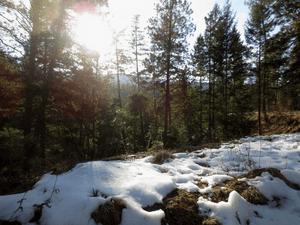Mission Creek (British Columbia) facts for kids
Quick facts for kids Mission Creek |
|
|---|---|
| Native name | N'wha-kwi-sen |
| Other name(s) | Rivière de l'Anse-au-Sable |
| Country | Canada |
| State | British Columbia |
| District | Central Okanagan |
| City | Kelowna |
| Physical characteristics | |
| Main source | British Columbia, Canada |
| River mouth | British Columbia, Canada 49°50′33″N 119°29′37″W / 49.84250°N 119.49361°W |
| Length | 75 km (47 mi) |
| Basin features | |
| Basin size | 860 km2 (330 sq mi) |
Mission Creek is a large creek located in the Okanagan Region of British Columbia, Canada. It starts in the Greystoke Mountain Range and flows west for about 43 kilometres (27 mi). Finally, it empties into Okanagan Lake just south of the city of Kelowna.
The creek's original name was N'wha-kwi-sen, which means "smoothing stones." Later, maps called it Rivière de l’Anse-au-Sable, or "Sandy Bay River." The name Mission Creek was chosen in 1860 to honor the Catholic Oblate Mission. This mission was started by Father Pandosy and other early settlers. The area that drains into Mission Creek, called its watershed, covers about 860 km2 (330 sq mi). In 1996, the province of British Columbia officially named Mission Creek a BC Heritage River.
Contents
Fish in Mission Creek: Kokanee Salmon
Mission Creek is very important for a special type of fish called Kokanee. These fish are a kind of salmon that live their whole lives in fresh water, unlike other salmon that go to the ocean. Mission Creek is the main place where Kokanee salmon lay their eggs.
Scientists believe these landlocked salmon first came into the Okanagan area a long time ago. This happened when a part of an ancient glacial lake was connected to the Pacific Ocean by streams.
Explore the Mission Creek Greenway
The Mission Creek Greenway is a long park that follows the creek. It stretches from the shores of Okanagan Lake all the way to Mission Creek Falls. This park is a great place to explore nature and see interesting geological features.
Along the trail, you can find many different natural formations. These include Layer Cake Hill, the Pinnacle, and the White Lake Formation. You might also see hoodoos, which are tall, thin rock formations. There are also signs of ancient river systems and huge boulders left behind by the Fraser Glacier.
How Mission Creek Has Changed
Over the years, people have changed Mission Creek a lot. They built dikes along the creek to control floods. These dikes made the creek channel narrower, especially from the East Kelowna Bridge to where it meets Okanagan Lake.
Because of these changes, Mission Creek has lost many of its natural features. These include riffles (shallow, fast-moving parts), stream pools (deeper, slower parts), and meanders (bends in the river). The creek also lost its natural connection to the floodplain and wetlands nearby. These changes have affected fish habitats, making it harder for fish to lay eggs, grow, and find safe places during high water.
In 1938, Mission Creek was much wider, up to 120 metres (390 ft) in some places. After dikes were built by 1951, the channel became narrower, about 50 metres (160 ft) wide. By 2006, it had shrunk even more, to only about 30 metres (98 ft) wide.
Mining History of Mission Creek
People started mining for valuable minerals in Mission Creek as early as the 1870s. Miners like Dan Gallagher continued to work along the creek until the 1940s.
A historian named Bill Barlee believes that a famous lost mine, called the McLean Mine, is located somewhere between the start of Mission Creek and Monashee Creek. McLean was a First Nations prospector who lived near Kelowna. There was also some placer mining in Mission Creek around the early 1900s. Placer mining is a way of finding gold or other heavy minerals in riverbeds.
Bridges Over Mission Creek
Many bridges cross Mission Creek, helping people travel around the area. Here is a list of some of the bridges, starting from the one closest to Okanagan Lake:
- Lakeshore Road - This bridge was rebuilt in the summer of 2014.
- Gordon Drive - This bridge was rebuilt in the summer of 2010.
- Casorso Road - This bridge was rebuilt in the summer of 2007.
- KLO Road
- East Kelowna Road
There are also other bridges further upstream, like those on forestry roads and highways, but they are not listed here.


